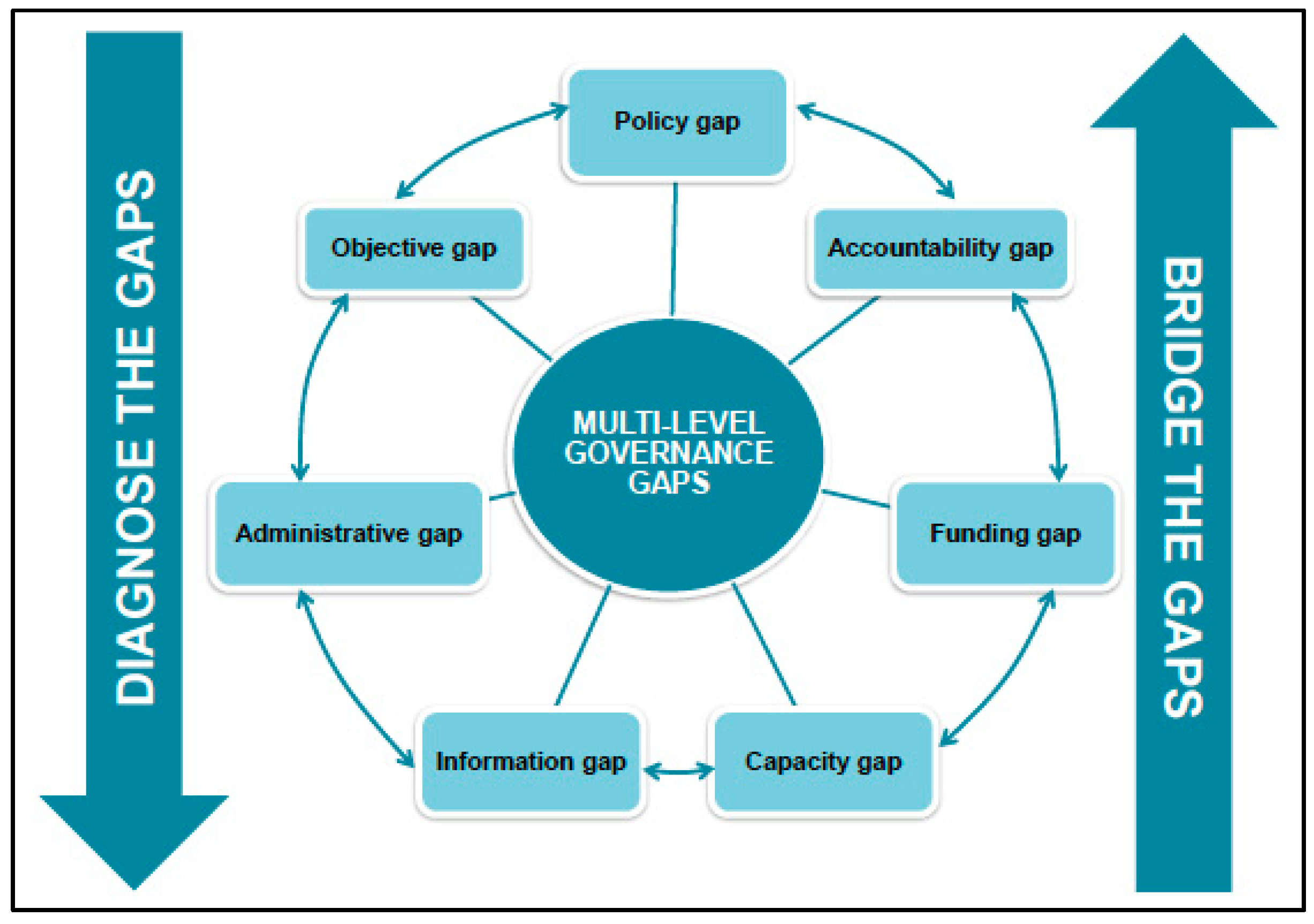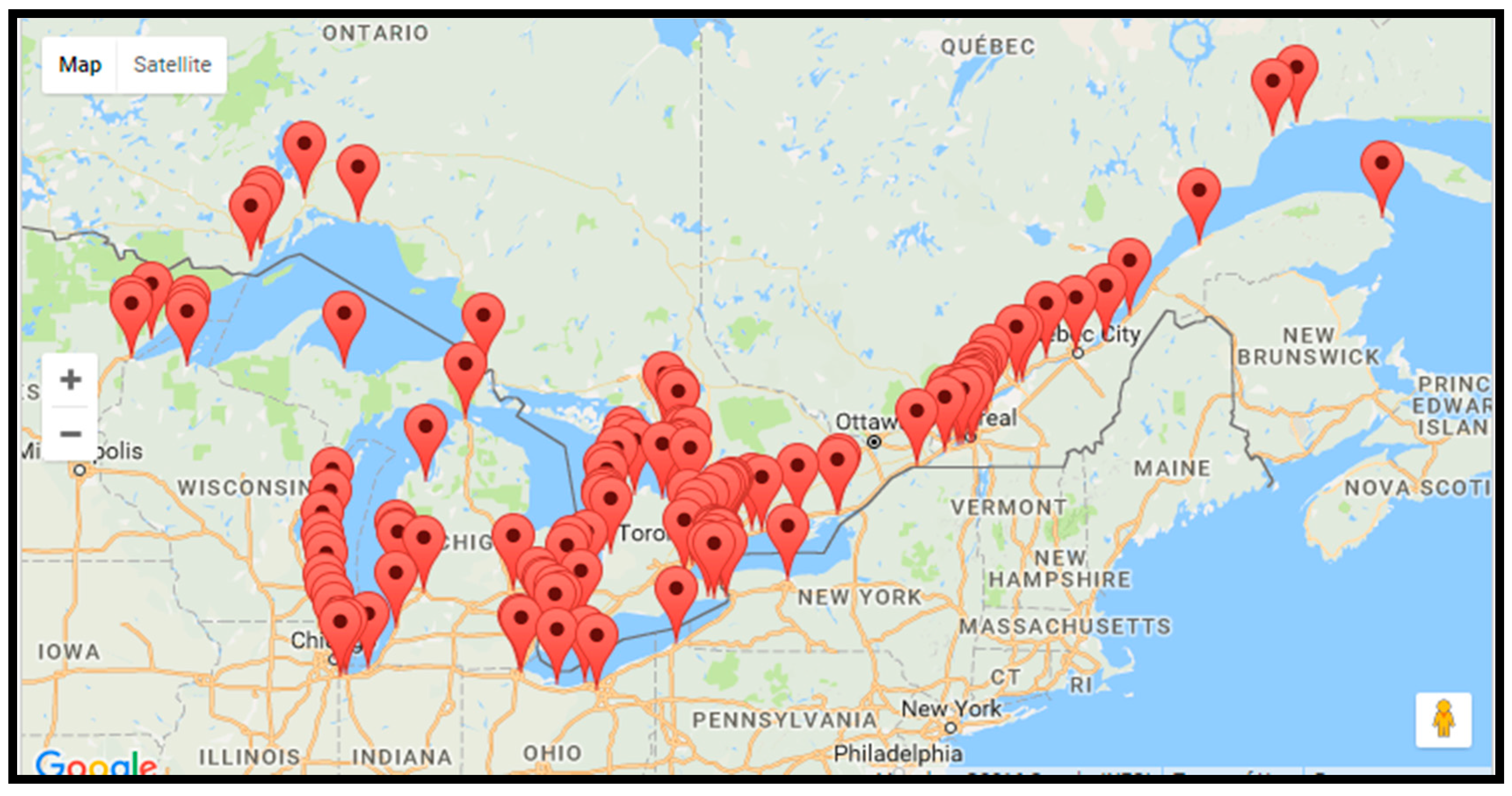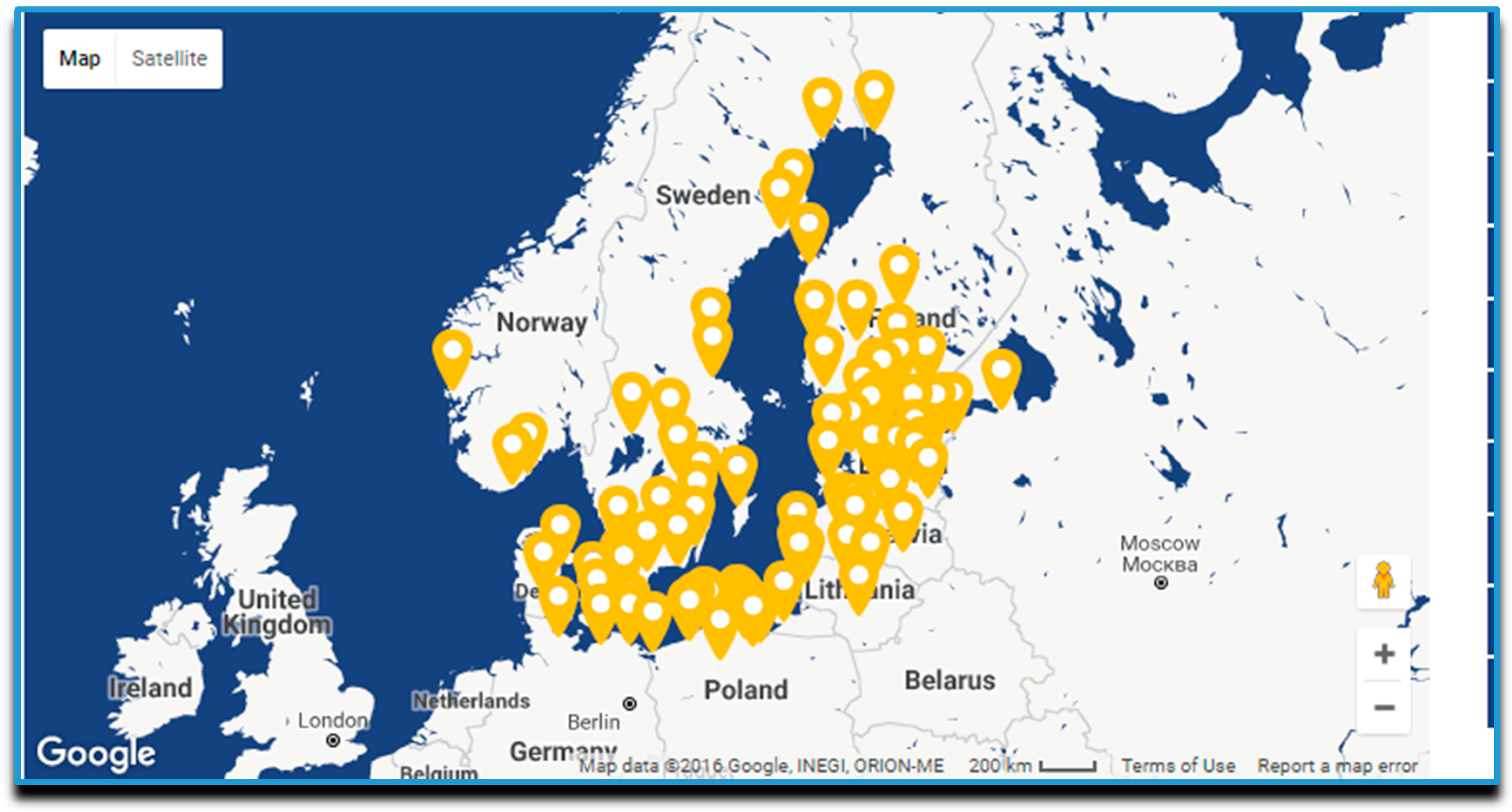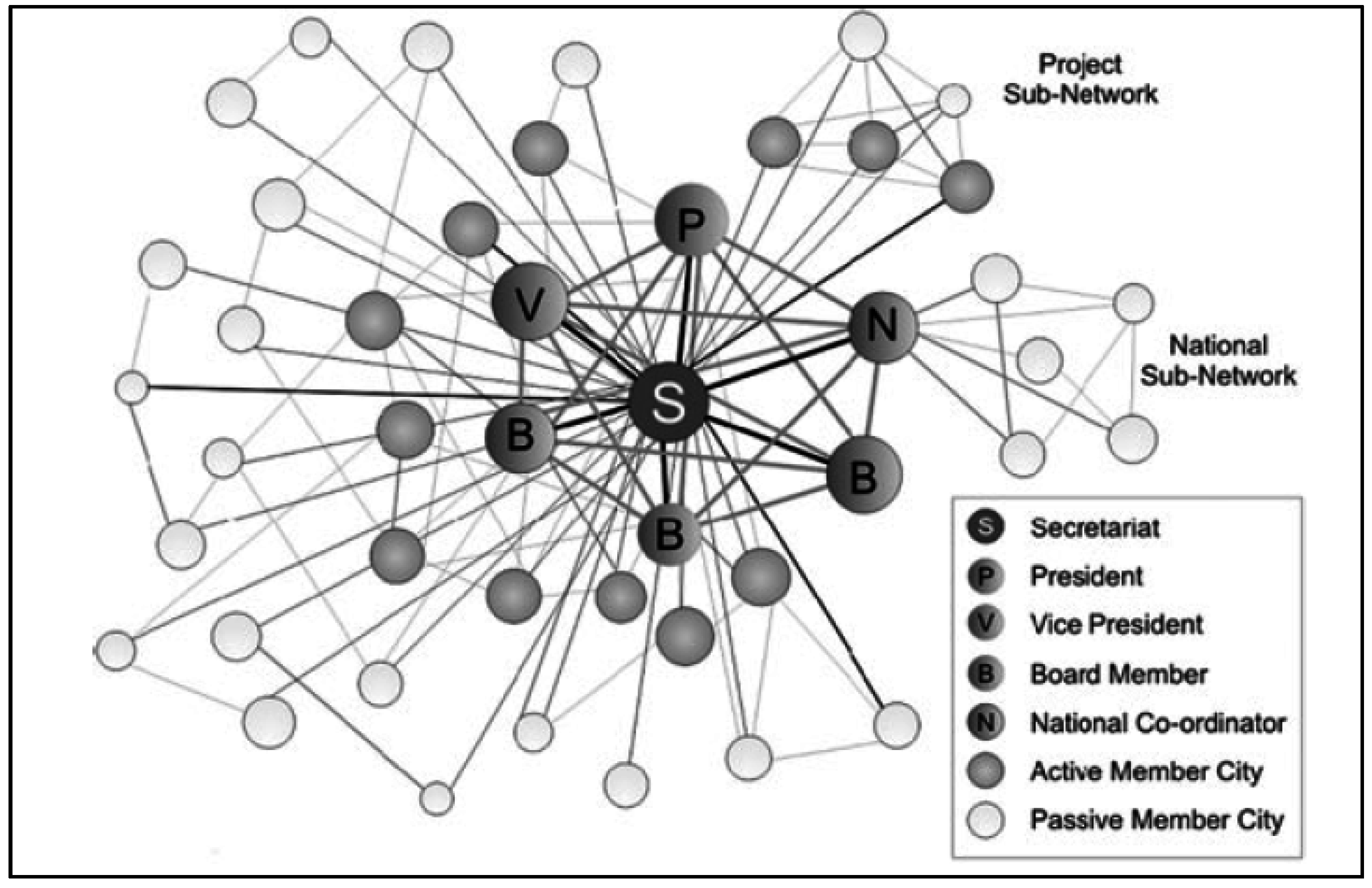The Role of Transnational Municipal Networks in Transboundary Water Governance
Abstract
:1. Introduction
2. Literature Review: Multilevel Governance, Water Governance, Transnational Municipal Networks
“The explicit or implicit sharing of policymaking authority, responsibility, development and implementation at different administrative and territorial levels, i.e., (i) across different ministries and/or public agencies at central government level (upper horizontally); (ii) between different layers of government at local, regional, provincial/state, national and supranational levels (vertically); and (iii) across different actors at the sub-national level (lower horizontally).”
2.1. Water Governance
“The governance of water in particular can be said to be made up of the range of political, social, economic and administrative systems that are in place, which directly or indirectly affect the use, development and management of water resources and the delivery of water services at different levels of society.”
2.2. Transnational Municipal Networks
The Evolution of Transnational Municipal Networks
3. Methodology-Bridging the Governance Gaps
3.1. Water Governance Gaps
- Funding Gap: Insufficient financial resources to execute water governance responsibilities is the main barrier to vertical and horizontal coordination of water policies. This was found in two-thirds of the OECD countries surveyed. This highlights the need for increased financing and innovative financing mechanisms.
- Capacity Gap: Insufficient scientific, technical and infrastructural capacity of local actors for design and implementation of water policies. It was identified as the second most important challenge in OECD countries, especially at the sub-national level. This highlights the need for local capacity building.
- Policy Gap: Fragmentation of water related responsibilities at all vertical levels, including national and sub-national and the lack of horizontal institutional coordination between policy fields. This was found in two thirds of the countries and highlight the need for mechanisms for cooperation and system wide approaches.
- Administrative Gap: Geographical mismatch between hydrological and administrative boundaries, leading to resource and supply gaps and implementation challenges. This highlights the need for instruments that reach the appropriate scale.
- Information Gap: Asymmetrical information (quantity, quality and type) amongst stakeholders involved in water policy. This highlights the need for better sharing of information.
- Accountability Gap: Lack of transparent practices across scales, largely due to insufficient users’ commitment, lack of concern, awareness and participation. This presents an obstacle for integrated water policy in half of the OECD countries surveyed. This highlights the need to strengthen the integrity framework at the local level, for citizen involvement and for quality instruments.
- Objective Gap: Different rationales create obstacles for adopting convergent targets, especially in the case of motivational gap. This highlights the need for instruments to align objectives.
3.2. Case Comparison
4. The Great Lakes and the Baltic Sea—The Tale of Two Large Transboundary Water Bodies
4.1. The Great Lakes and St. Lawrence Cities Initiative
4.2. The Union of Baltic Cities
5. Bridging the Governance Gaps—The Role of Transnational Municipal Networks in Transboundary Water Governance
5.1. The Funding Gap
5.2. The Capacity Gap
- To launch a Baltic Smart Water hub
- To facilitate capacity building for water management and support knowledge based communities
- To increase UBC cities capacity for integrated water management
5.3. The Administrative Gap
5.4. The Information Gap
5.5. The Accountability Gap
5.6. The Objective Gap
5.7. The Policy Gap
6. Additional Analysis and Discussion
6.1. Clustering and Its Impact on Transboundary Water Governance
6.2. Key Emerging Themes—Governance Modes
6.2.1. Self Governing Strategies
6.2.2. External Governing Strategies
6.3. Enhancing Policy Transfer and Policy Learning
7. Conclusions
Acknowledgments
Author Contributions
Conflicts of Interest
References
- The Great Lakes Water Quality Agreement. Protocol 2012 (Further Updates of the 1972 Version). Available online: https://www.epa.gov/glwqa (accessed on 9 January 2017).
- Baltic Marine Environment Protection Commission (HELCOM). Convention on the Protection of the Marine Environment Baltic Sea Area; HELCOM: Helsinki, Finland, 1974. [Google Scholar]
- Organisation for Economic Co-Operation and Development (OECD). Water Governance in OECD Countries: A Multi-Level Approach, OECD Studies on Water; OECD Publishing: Paris, France, 2011. [Google Scholar]
- Hooghe, L. Cohesion Policy and European Integration: Building Multi-Level Governance; Oxford University Press: Oxford, UK, 1996. [Google Scholar]
- Piattoni, S. Multi-level governance: A historical and conceptual analysis. Eur. Integr. 2009, 31, 163–180. [Google Scholar] [CrossRef]
- Hooghe, L.; Marks, G. Types of multi-level governance. Eur. Integr. Online Pap. (EIoP) 2001, 5, 17–31. [Google Scholar]
- United Nations (UN). Water: A Shared Responsibility; World Water Assessment Programme: Colombella, Italy, 2002. [Google Scholar]
- Bakker, K. Privatizing Water: Governance Failure and the World’s Urban Water Crisis; Cornell University Press: New York, NY, USA, 2010. [Google Scholar]
- Rogers, P.; Hall, A. Effective Water Governance; Global Water Partnership: Stockholm, Sweden, 2003; Volume 7. [Google Scholar]
- Nye, J.; Keohane, R. Transnational relations and world politics: An introduction. Int. Organ. 1971, 25, 329–349. [Google Scholar] [CrossRef]
- Risse-Kappen, T. Bringing transnational relations back. In Non-State Actors, Domestic Structures and International Institutions; Cambridge University Press: Cambridge, UK, 1995; Volume 42. [Google Scholar]
- Betsill, M.; Corell, E. NGO Diplomacy: The Influence of Nongovernmental Organizations in International Environmental Negotiations; MIT Press: Boston, MA, USA, 2008. [Google Scholar]
- Schiller, N.G.; Basch, L.; Blanc-Szanton, C. Towards a definition of transnationalism. Ann. N. Y. Acad. Sci. 1992, 645, 9–14. [Google Scholar] [CrossRef]
- Haas, P.M. Introduction: Epistemic communities and international policy coordination. Int. Organ. 1992, 46, 1–35. [Google Scholar] [CrossRef]
- Risse, T. Global governance and communicative action. Gov. Oppos. 2004, 39, 288–313. [Google Scholar] [CrossRef]
- Betsill, M.; Bulkeley, H. Looking back and thinking ahead: A decade of cities and climate change research. Local Environ. 2007, 12, 447–456. [Google Scholar] [CrossRef]
- Fink, A. Under what conditions may social contracts arise? Evidence from the Hanseatic League. Const. Political Econ. 2011, 22, 173–190. [Google Scholar] [CrossRef]
- 7th Strategy Forum of the EU Strategy for the Baltic Sea Region. Available online: http://www.strategyforum2016.eu (accessed on 9 January 2017).
- Commission of the European Communities (CEC). Green Paper: Towards a New Culture for Urban Mobility; Office for Official Publications of the European Communities: Luxembourg, 2007. [Google Scholar]
- Bache, I. Europeanization and multi-level governance: EU cohesion policy and pre-accession aid in Southeast Europe. Southeast Eur. Black Sea Stud. 2010, 10, 1–12. [Google Scholar] [CrossRef]
- Rosamond, B. New theories of European integration. In European Union Politics; Cini, M., Ed.; Oxford University Press: Oxford, UK, 2007. [Google Scholar]
- Ladrech, R. The Europeanization of interest groups and political parties. In The Member States of the European Union; Bulmer, S., Lequesne, C., Eds.; Oxford University Press: Oxford, UK, 2005. [Google Scholar]
- Eurocities. About EUROCITIES. Available online: http://www.eurocities.eu/eurocities/about_us (accessed on 22 November 2016).
- Westerhoff, L. Planned adaptation measures in industrialized countries a comparison of select countries within and outside the EU. In Developing Adaptation Policy and Practice in Europe: Multi-Level Governance of Climate Change; Keskitalo, E., Carina, H., Eds.; Springer: Dordrecht, The Netherlands, 2010; pp. 271–332. [Google Scholar]
- United Nations Environment Programme (UNEP). UNEP Unveils the Climate Neutral Network to Catalyze a Transition to a Low Carbon World. 2008. Available Online: http://www.unep.org/Documents.Multilingual/Default.asp?DocumentID=528&ArticleID=5750&l=en (accessed on 22 November 2016).
- Osofsky, H.; Levit, J. The scale of networks? Local climate change coalitions. Chic. J. Int. Law 2008, 8, 409–436. [Google Scholar]
- Jetoo, S.; Thorn, A.; Friedman, K.; Gosman, S.; Krantzberg, G. Governance and geopolitics as drivers of change in the Great Lakes—St. Lawrence basin. J. Gt. Lakes Res. 2015, 41, 108–118. [Google Scholar] [CrossRef]
- Renn, O.; Klinke, A.; van Asselt, M. Coping with complexity, uncertainty and ambiguity in risk governance: A synthesis. Ambio 2011, 40, 231–246. [Google Scholar] [CrossRef] [PubMed]
- George, A.L.; Bennett, A. Case Studies and Theory Development in the Social Sciences; MIT Press: Boston, MA, USA, 2005. [Google Scholar]
- Botts, L.; Krsushelnicki, B. The Great Lakes: An Environmental Atlas and Resource Book; Government of Canada and United States Environmental Protection Agency: Ottawa, ON, Canada; Washington, DC, USA, 1995.
- Grover, V.I.; Krantzberg, G. Great Lakes—great responsibilities: History of and lessons in participatory governance. In Great Lakes: Lessons in Participatory Governance; CRC Press: Boca Raton, FL, USA, 2012; pp. 13–43. [Google Scholar]
- Manninen, C.; Gauthier, R. Living with the Lakes: Understanding and Adapting to Great Lakes Water Level Changes; U.S. Army Corps of Engineers and Great Lakes Commission: Ann Arbor, MI, USA, 1999. [Google Scholar]
- Hildebrand, L.; Pebbles, V.; Fraser, D. Cooperative ecosystem management across the Canada–US border: Approaches and experiences of transboundary programs in the Gulf of Maine, Great Lakes and Georgia Basin/Puget Sound. Ocean Coast. Manag. 2002, 45, 421–457. [Google Scholar] [CrossRef]
- Encyclopedia Britannica. Baltic Sea. 2007. Available online: https://global.britannica.com/place/Baltic-Sea (accessed on 12 November 2016).
- Eakins, B.; Sharman, G. Volumes of the World’s Oceans from ETOPO1; NOAA National Geophysical Data Center: Boulder, CO, USA, 2010. [Google Scholar]
- Baltic Marine Environment Protection Commission (HELCOM). Ecosystem Health of the Baltic Sea 2003–2007: HELCOM Initial Holistic Assessment; Baltic Sea Environment Proceedings No. 122; Helsinki Commission: Helsinki, Finland, 2010. [Google Scholar]
- Gänzle, S. Introduction: Transnational governance and policy-making in the Baltic Sea region. J. Balt. Stud. 2011, 42, 1–7. [Google Scholar] [CrossRef]
- Kern, K.; Loffelsend, T. Sustainable development in the Baltic Sea Region. Governance beyond the nation state. Local Environ. 2004, 9, 451–467. [Google Scholar] [CrossRef]
- The Great Lakes and St. Lawrence Cities Initiative. About the Great Lakes and St. Lawrence Cities Initiative. Available online: http://glslcities.org/about-the-great-lakes-and-st-lawrence-cities-initiative/ (accessed on 20 November 2016).
- Kern, K.; Löffelsend, T. Governance beyond the nation state: Transnationalization and Europeanization of the Baltic Sea Region. In Governing a Common Sea: Environmental Policies in the Baltic Sea Region; Routledge: Abingdon, UK, 2008; pp. 115–141. [Google Scholar]
- The Union of Baltic Cities. The Union of Baltic Cities Website. Available online: http://www.ubc.net (accessed on 19 November 2016).
- Great Lakes and St. Lawrence Cities Initiative (GLSCI). Great Lakes and St. Lawrence Cities Initiative Consolidated Financial Statements. 2008. Available online: http://glslcities.org/wp-content/uploads/2015/05/2007-2008-Annual-Report-EN.pdf (accessed on 6 January 2017).
- University of British Columbia (UBC). UBC Financial Document. 2008. Available online: http://www.ubc.net/sites/default/files/financial_documents_0.pdf (accessed on 22 November 2016).
- University of British Columbia (UBC). Reports and Action Plans of the UBC Commission. 2009. Available online: http://www.ubc.net/sites/default/files/reports_and_action_plans_of_ubc_commissions.pdf (accessed on 22 November 2016).
- Union of Baltic Cities. Stairway towards Sustainable Cities. Available online: http://www.ubc.net/cities (accessed on 21 November 2016).
- Great Lakes Protection Act. 2015. Available online: https://www.ontario.ca/laws/statute/15g24 (accessed on 2 December 2016).
- City of Toronto. Ontario and Great Lakes Municipalities Sign Pact. News Release. 2008. Available online: https://news.ontario.ca/ene/en/2008/07/ontario-and-great-lakes-municipalities-sign-pact.html (accessed on 28 November 2016).
- Canada Ministry of Environment and Climate Change. Canada-Ontario Agreement (COA) Respecting the Great Lakes Basin Ecosystem. Available online: https://www.ontario.ca/page/canada-ontario-agreement-coa-respecting-great-lakes-basin-ecosystem (accessed on 4 December 2016).
- Kern, K.; Bulkeley, H. Cities, Europeanization and multi-level governance: Governing climate change through transnational municipal networks. JCMS J. Common Mark. Stud. 2009, 47, 309–332. [Google Scholar] [CrossRef]
- ATKearney. Global Cities 2016. Available online: https://www.atkearney.com/documents/10192/8178456/Global+Cities+2016.pdf/8139cd44-c760–4a93-ad7d-11c5d347451a (accessed on 28 November 2016).
- Triantafillou, P. Governing the formation and mobilization of governance networks. In Theories of Democratic Network Governance; Palgrave Macmillan: London, UK, 2007; pp. 183–198. [Google Scholar]
- Joas, M.; Kern, K.; Sandberg, S. Actors and arenas in hybrid networks: Implications for environmental policymaking in the Baltic Sea region. Ambio 2007, 36, 237–242. [Google Scholar] [CrossRef]
- Dolowitz, D.; Marsh, D. Learning from abroad: The role of policy transfer in contemporary policy-making. Governance 2000, 13, 5–24. [Google Scholar] [CrossRef]




© 2017 by the author; licensee MDPI, Basel, Switzerland. This article is an open access article distributed under the terms and conditions of the Creative Commons Attribution (CC-BY) license (http://creativecommons.org/licenses/by/4.0/).
Share and Cite
Jetoo, S. The Role of Transnational Municipal Networks in Transboundary Water Governance. Water 2017, 9, 40. https://doi.org/10.3390/w9010040
Jetoo S. The Role of Transnational Municipal Networks in Transboundary Water Governance. Water. 2017; 9(1):40. https://doi.org/10.3390/w9010040
Chicago/Turabian StyleJetoo, Savitri. 2017. "The Role of Transnational Municipal Networks in Transboundary Water Governance" Water 9, no. 1: 40. https://doi.org/10.3390/w9010040
APA StyleJetoo, S. (2017). The Role of Transnational Municipal Networks in Transboundary Water Governance. Water, 9(1), 40. https://doi.org/10.3390/w9010040




